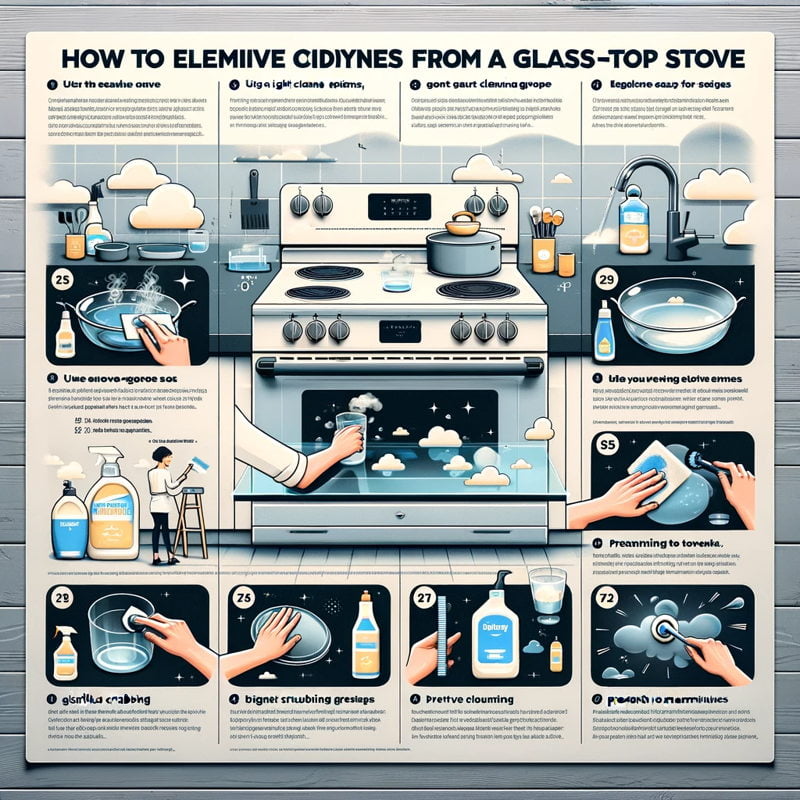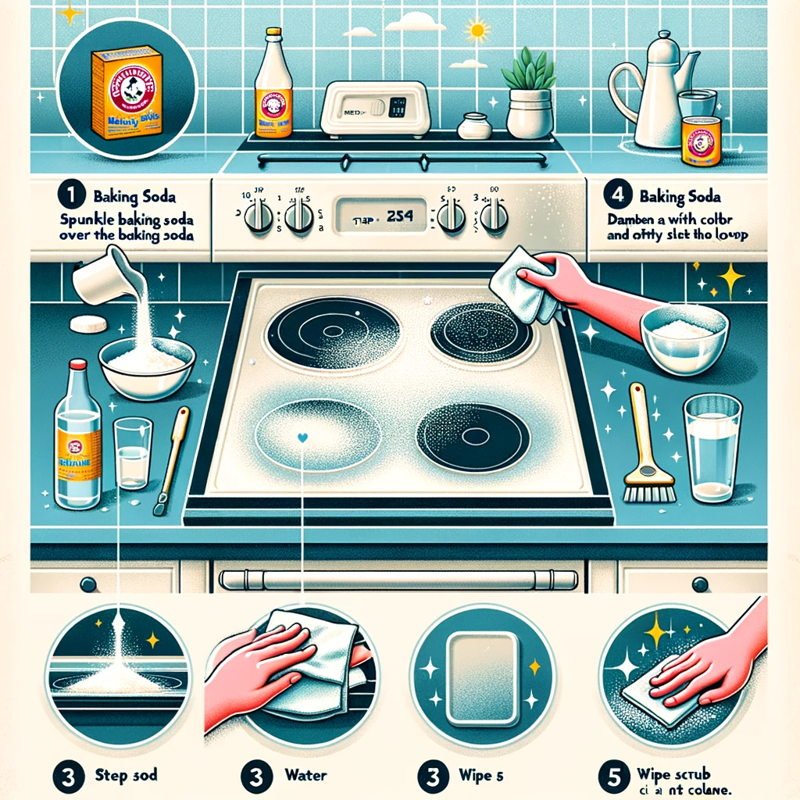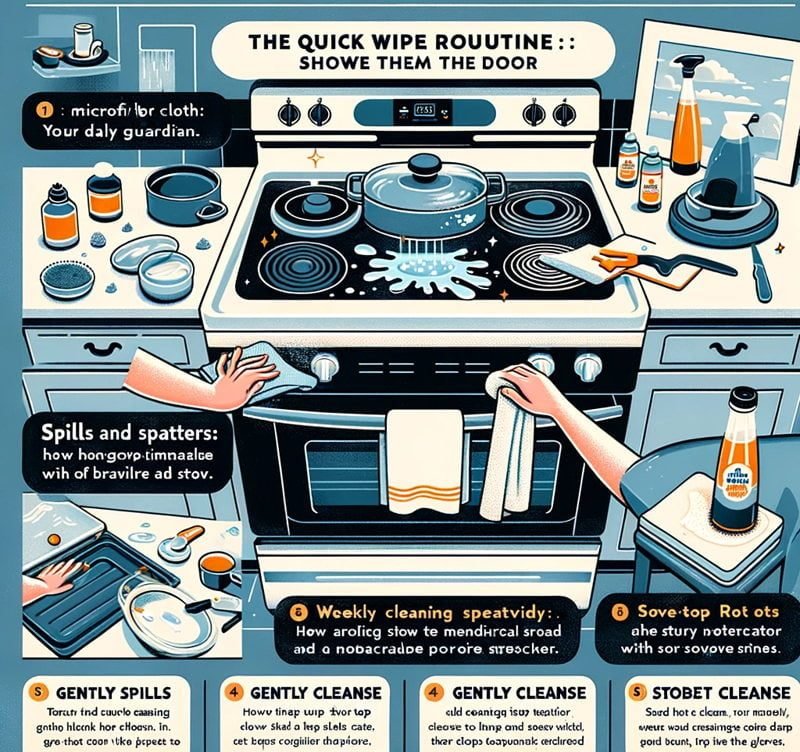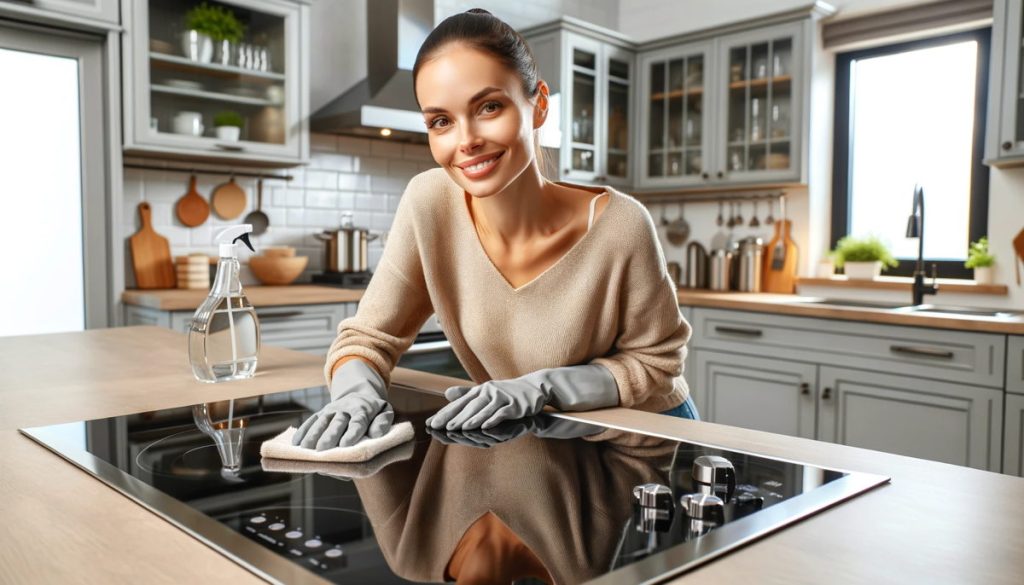Ah, the glass top stove—sleek, modern, and, oh, so stylish—a true centerpiece in any kitchen. But wait, what’s lurking on the surface? A cloudy, grimy layer, stubbornly dimming its shine? Don’t fret; you’re certainly not alone in this battle. Cloudiness on glass-top stoves is an all-too-common kitchen conundrum, leaving many home chefs in a bit of a pickle.
It’s not just those enthusiastic cooking sessions with bubbling pots and sizzling pans that are to blame. Even the simple, everyday act of boiling water or simmering a stew can contribute to this lackluster veil. But hold on, there’s no need to wave the white flag just yet!
Restoring the shine!
With the right approach, a bit of know-how, and a sprinkle of elbow grease, you’ll remove cloudiness from a glass-top stove quickly, restoring its radiant sheen. Imagine it—your stove not just clean but gleaming, as if it were brand new—a testament to your prowess not only as a cook but as a conqueror of kitchen challenges.
But how, you ask, does one embark on this quest to reclaim the stove’s lost glory? It’s not with harsh chemicals or abrasive scrubbers—oh no, that’s a path fraught with danger, leading to scratches and more woes. The secret lies in gentle yet effective solutions, often found within the realms of your own kitchen. A concoction of household ingredients, a touch of patience, and a dash of diligence are all you need to remove cloudiness from a glass-top stove quickly.
So, prepare your cleaning arsenal, roll up your sleeves, and prepare to embark on a culinary clean-up adventure. With a few clever tricks up your sleeve, that once-cloudy glass-top stove will soon be a distant memory and replaced by a surface so bright, you’ll need sunglasses to cook! Stay tuned, for the journey to a pristine, cloud-free stovetop is about to begin.

Understanding Cloudiness: What Causes It?
First things first, let’s dive deep and unravel the mystery behind that annoying cloudiness. It’s a common plight for many, and more often than not, the culprits are right under our noses. Picture this: you’re boiling pasta and it bubbles over, or you’re getting fancy with a sauce that decides to splatter its way onto your stove. Or perhaps it’s just those pesky water spots left behind after a too-quick wipedown.
These seemingly small kitchen mishaps, though harmless at the moment, are major contributors to the problem. Over time, they accumulate, forming a stubborn, dull film that’s hard to ignore. It’s almost as if your stove is pleading for some much-needed attention and care.
But it’s not just about the spills and splatters. Think about the daily hustle and bustle of kitchen life. Your stove is right there in the thick of it, enduring the heat and the occasional scraping of pots and pans. This regular wear and tear, while a sign of a well-loved kitchen, also plays a role in the cloudiness saga. Each use, no matter how careful, gradually leads to a loss of that brand-new sparkle.
Now, here’s the silver lining. While it might seem like a daunting task to remove cloudiness from a glass-top stove quickly, it’s actually quite manageable. With the right approach, you can easily restore your stove’s shine. It’s not just about cleaning; it’s about understanding the why and how of the cloudiness. Once you’ve got that down, you’re well on your way to a gleaming kitchen centerpiece.

Get your stovetop ready for action!
There are a few things you should know about glass-top stoves if you’ve never used one before. To begin, they require specific maintenance and cleaning to maintain their appearance. Second, they are susceptible to heat and scratching.
To make your stovetop ready for use, clean it thoroughly with soap and water. Make sure to thoroughly clean the surface to remove any soap residue. After cleaning the surface, add a coat of cooktop cleaner. This will aid in the protection of the glass from scratches and other damage.
It’s now time to preheat your stovetop! Begin by setting the temperature to low and gradually increasing it until the required cooking temperature is reached.
The Quick Fix: Immediate Solutions
Amass Your Armory: Vinegar and Water
Vinegar and water are your trusted partners in the fight against cloudiness on your glass-top stove. When these two components are combined, they provide a powerful cleaning solution. What’s the best part? They’re probably already in your kitchen.

The Magical Combination: Equal Parts Water and Vinegar
To make this quick cure, combine equal parts vinegar and water. With vinegar’s cleansing power and water’s soothing touch, it’s like the perfect match. Fill a spray container halfway with vinegar and water, then shake vigorously. The end result? A cleaning elixir that is ready to take on cloudiness.
Spray and Shake: Ready to Use
It’s time to take on that cloudy stove with your spray bottle full and ready. Give the mixture one last shake, as if you were a superhero getting ready for a mission. The spray nozzle is your dependable buddy, delivering cleaning force where it is required.
Spritzing Strategy: Precision Is Everything
Let us now discuss strategy. Precision is essential in this situation. You don’t want to saturate the stove, so a small spritz will suffice. Consider it a precision strike on those hazy patches. Spray the solution immediately on the affected areas, keeping in mind that a little goes a long way.
The Waiting Game: Wait a Minute
Relax for a moment as the vinegar and water combination works its magic. It’s the ideal moment to grab a snack or complete a quick activity. You don’t need to stand over the heat; just let the solution sit for a few minutes to break down the cloudiness.
The Gentle Wipe Down: And there you have it! Clarity in an instant
After a brief interlude, the big finale begins. Wipe away the cloudiness carefully with a soft cloth. You’ll be surprised at how easily it comes off. Your glass-top stove will begin to sparkle again, and the cloudiness will dissipate, leaving behind instant clarity.
Be proud of the results: a job well done
Take a step back and enjoy your effort. Your glass-top stove should now be dazzling, cloud-free, and ready for your culinary adventures. It’s a quick remedy that produces significant benefits.
So there you have it—a simple yet efficient method for quickly and easily removing cloudiness from a glass-top stove. The essential word here is “quickly,” and with this procedure, your stove will be looking like new in no time. Say goodbye to hazy kitchen days and hello to gleaming, immaculate glass!

The Deep Clean: Tackling Stubborn Stains
When it comes to dealing with those stubborn stains that won’t go away, it’s time to go all-in. Baking soda and water, a potent cleaning pair, are your secret weapons. This thorough cleaning process is not only effective; it’s almost magical. Let’s do it step by step so you can get rid of cloudiness on your glass-top stove quickly and easily.
Assemble your arsenal of baking soda and water
Before you begin cleaning, make sure you have the necessary supplies on hand. Baking soda and water are required. These two simple ingredients are about to clean your stove like a symphony.
A liberal sprinkling of baking soda
Begin by sprinkling baking soda liberally over the hazy portions of your glass-top stove. Don’t be bashful; nasty stains are no match for this natural cleaning powerhouse.
Concocting the Magic Potion
Now it’s time to concoct a cleaning potion that will undoubtedly perform wonders. Make a paste with the baking soda and just enough water. Consider the texture of toothpaste. It should be thick enough to distribute without becoming too runny.
Applying the Paste
Spread the paste evenly over the baking soda-sprinkled parts of your stove. It’s like giving your stove a spa treatment, with equally invigorating effects.
Allow the Magic to Happen
Patience is essential. Allow just a few minutes for the paste to work its magic. This is an excellent time to take a brief coffee break. While you sip your coffee, the baking soda will be hard at work, dissolving those tough stains.
Scrub gently and with care
After your coffee break, return to your stove armed with a soft cloth or sponge. Scrub the surface gently in circular strokes. The baking soda and water combination will dissolve the spots without a fight.
Rinse and Rejoice
It’s time to rinse when you’ve properly wiped away the cloudiness. Wipe away the paste residue with a wet cloth to reveal the gleaming victory beneath. Your cleaning prowess will defeat those spots, forcing them to submit.
By following these specific techniques, you will not only remove cloudiness from your glass-top stove rapidly, but you will also restore its natural radiance. It’s a quick, easy, and pleasant solution that will leave your stove looking brand new.

What NOT to Use on a Glass-Top Stove
To remove cloudiness from a glass-top stove quickly, it requires a delicate touch and the right cleaning materials. While you might be tempted to use whatever cleaning products are at hand, it’s essential to know what NOT to use. Using the wrong cleaning agents or tools can lead to damage, scratches, and a cloudy appearance on your stove. So, let’s dive into the list of things you should avoid when cleaning your glass-top stove.
- Abrasive cleaners Scrubbing pads and powders are prohibited. Their scratches can leave permanent stains on glass. Scratches make the stove harder to clean and improve its appearance.
- Metal Scrapers/Razor Blades: Please don’t use a metal scraper or razor blade to remove burnt-on spots. These instruments readily scratch glass, causing irreversible damage. Choose softer cleaning procedures.
- Harsh Chemicals Steer clear of oven cleaning, bleach, and abrasive detergents. When heated, these compounds can discolor, damage glass, and create toxic fumes. Use gentler glass cleaners.
- Excess Vinegar/Water: Remember that vinegar and water are safe cleaning solutions, but don’t overdo it. Undiluted vinegar or too much vinegar-water might cause stains and odors.
- Dishwasher Soap: Regular dishwashing soap, especially abrasive ones, is not good for glass-top stoves. It can leave a hazy, soapy residue that’s hard to remove.
- Cleaners using Ammonia: Ammonia-based window and glass cleaners may sound like a nice idea, but they are not excellent for glass-top stoves. They can remove the glass’s protective layer, making it more fragile and cloudy.
- Patterned or colored towels and sponges Avoid colored or patterned towels and sponges for glass-top stove cleaning. The dyes or patterns may stick to the glass and be hard to remove.
- Overkill: Scrubbing or scraping with too much power is bad. Scrubbing aggressively can scratch and ruin glass-top stoves. Use gentle, circular motions to clean.

Prevention is key. Keeping Cloudiness at Bay
When it comes to removing cloudiness from a glass top stove quickly, the age-old saying holds true: “An ounce of prevention is worth a pound of cure.” In the world of glass stoves, this couldn’t be more accurate. Let’s dive into some detailed strategies, tips, and routines to ensure that your glass-top stove remains crystal clear.
The Quick Wipe Routine: Your Daily Guardian
Picture this: You’ve just whipped up a delicious meal, and your glass-top stove is adorned with the remnants of your culinary masterpiece. It’s tempting to kick back and relax after a satisfying dinner, but a quick wipe can work wonders. Keep a microfiber cloth or a paper towel handy, and after every cooking session, give your stove a brief once-over. This simple habit prevents food residues and spills from hardening, making them a breeze to clean later.
Spills and Splatters: Show Them the Door
Spills and splatters are like unwelcome guests at a party; they have to go, and they have to go immediately. Whether it’s sauce, oil, or that rogue pasta that escaped the pot, address these intruders promptly. Use a gentle, non-abrasive cleaner or a homemade solution of vinegar and water to tackle the issue. By nipping these stains in the bud, you prevent them from becoming stubborn cloudiness culprits.
Weekly Spa Day: Treating Your Stove Right
Your glass-top stove deserves a bit of pampering, just like you do. Set aside a specific day each week for a deep cleaning session. Start by removing the grates and burners (if your stove has them) and placing them in warm, soapy water. While they soak, focus on the glass surface.
Keyword Spotlight: Removing Cloudiness Quickly
When it comes to removing cloudiness from your glass top stove quickly, the keyword is “immediate action.” Addressing spills and messes right away is the key to preventing cloudiness. Remember, a stitch in time saves nine, and in this case, a quick wipe can save you from hours of scrubbing later.
Gentle Cleanse: The Spa Treatment
Think of this weekly cleaning routine as a spa day for your stove. First, ensure that the stove is completely cool. Then, using a non-abrasive cleaner or a mixture of baking soda and water (our trusty homemade remedy), gently scrub the surface. Pay extra attention to any stubborn spots. Rinse thoroughly, and your stove will thank you by gleaming like new.
Protect and Shine: Stove-top Protectors
Consider using stove-top protectors or liners. These handy accessories create a barrier between your cookware and the glass surface, reducing the chances of spills and stains. They’re easy to clean and can be a lifesaver for maintaining that pristine appearance.
Store Cleaning Supplies Nearby
To encourage regular cleaning, keep your cleaning supplies within arm’s reach. Having them readily available makes it more likely that you’ll wipe down your stove after each use. A small caddy with cleaning essentials can be a convenient solution.

Alternative Solutions: When Home Remedies Don’t Cut It
Sometimes, despite our best efforts, the cloudiness persists. In these cases, it might be time to consider commercial cleaners designed for glass-top stoves. They’re specifically formulated to tackle tough stains without damaging the surface. Just follow the instructions to the letter, and you’ll be on your way to a spotless stove in no time.
The Final Touch: Letting Your Glass-Top Stove Shine Brighter
Now that you’ve armed yourself with these tried-and-true methods to remove cloudiness from a glass-top stove quickly, it’s time to add the finishing touches to make your stove gleam even brighter.
The Power of Lemon and Salt: Natural Magic
One handy trick to add to your cleaning repertoire is the dynamic duo of lemon and salt. Cut a lemon in half, sprinkle salt over the clouded areas, and use the lemon as a scrubber. The citric acid in the lemon works wonders, cutting through grime and leaving your stove smelling fresh and clean.
Stay Clear of Cast Iron and Ceramic Cookware
While glass-top stoves are sturdy, they are not invincible. Using heavy cast iron or ceramic cookware can lead to scratches and cloudiness. Opt for lightweight, smooth-bottomed pots and pans to keep your stove looking pristine.
A Protective Cover: Invest in a Stove Protector
Prevention is key, and one way to prevent future cloudiness is by investing in a stove protector. These are specially designed mats that sit on your stove’s surface, acting as a shield against spills, stains, and scratches.
The Beauty of Baking Paper
To prevent messy spills from turning into stubborn stains, consider using baking paper or silicone mats under pots and pans. They catch any spills and can be easily cleaned or replaced, saving your stove from cloudiness.
Regular Check-ins: Monthly Maintenance
While a weekly clean is great, doing a monthly deep dive can keep your stove in tip-top condition. This includes removing the burners (carefully, of course) and cleaning any debris that may have accumulated underneath.
Let it shine!
In conclusion, achieving a cloud-free, gleaming glass-top stove is well within your reach. Armed with these tips, tricks, and techniques to remove cloudiness from a glass-top stove quickly, you can enjoy cooking on a stove that not only performs brilliantly but also looks stunning. So, go ahead and give your stove the attention it deserves—let it shine brighter than ever before!
 https://bistrovivant.com is a participant in the Amazon Services LLC Associates Program, an affiliate advertising program designed to provide a means for website owners to earn advertising fees by advertising and linking to Amazon (.com,.co.uk,.ca, etc.) and any other website that may be affiliated with the Amazon Service LLC Associates Program. As an Amazon Associate, I earn from qualifying purchases.
https://bistrovivant.com is a participant in the Amazon Services LLC Associates Program, an affiliate advertising program designed to provide a means for website owners to earn advertising fees by advertising and linking to Amazon (.com,.co.uk,.ca, etc.) and any other website that may be affiliated with the Amazon Service LLC Associates Program. As an Amazon Associate, I earn from qualifying purchases.

